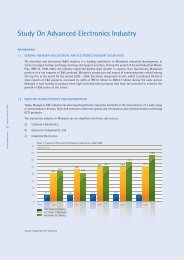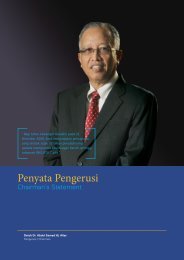Oil and Gas Industry
oil and gas indUstrY - Bank Pembangunan Malaysia Berhad
oil and gas indUstrY - Bank Pembangunan Malaysia Berhad
Create successful ePaper yourself
Turn your PDF publications into a flip-book with our unique Google optimized e-Paper software.
<strong>Oil</strong> <strong>and</strong> <strong>Gas</strong> <strong>Industry</strong>Annual Report 201258Bank PembangunanMalaysia Berhad (16562-K)Upstream Activities• Since its creation in 1974, national oil company PETRONAShas shaped <strong>and</strong> guided Malaysia’s hydrocarbons industry.Punching considerably above its weight, the companyhas succeeded on the world stage, building overseasassets in Asia Pacific, the Middle East, Africa <strong>and</strong> nowNorth America.• However, the national oil company has somewhat neglecteddomestic production <strong>and</strong> exploration efforts. In 2011,the country’s crude output fell below 600,000 barrelsof oil per day (bopd) to 573,000 for the first time in adecade, according to data from the BP Stastical Reviewof World Energy.• As such, the country badly needs to enhance explorationefforts <strong>and</strong> capitalize on its undiscovered resources, whichare estimated at up to 10 billion barrels in deep- <strong>and</strong> ultradeepwater, of which 65 percent are in deep water.• With this in mind, PETRONAS <strong>and</strong> its exploration armPetronas Carigali have devised a three-pronged approachto reverse the nation’s production fortunes. Targetting thedevelopment of the country’s marginal fields, deepwaterexploratory drilling <strong>and</strong> the revitalization of mature assets,capital expenditure on exploration is set to soar over thenext decade, with much of this being ploughed into thecountry’s offshore opportunities.Marginal Fields• The first prong of Malaysia’s bid to boost flagging productionis to encourage the development of the country’s marginalfields. These assets, typically holding less than 30 millionbarrels of reserves, are of little interest to internationaloil companies focused on l<strong>and</strong>ing the far larger offshoredeposits, but offer smaller, nimbler players the chance toleverage their experience in enhanced oil recovery (EOR)techniques <strong>and</strong> rapid mobilization.• Although the individual fields may not add up to muchindividually, with many of the sites having 10 millionbarrels worth of reserves or less, Malaysia’s 106 combinedmarginal sites hold a healthy 580 million barrels of oilequivalent, according to research from investment bankJP Morgan.• For the time being, PETRONAS has plans to developonly 27 of these, leading to speculation over whetherthe increase from marginal fields can make a seriousimpact on the country’s overall production profile. Keento incentivize smaller players to take up the marginal fieldchallenge, PETRONAS has decided to forgo the st<strong>and</strong>ardproduction-sharing contract (PSC) in favour of a moretailored risk-sharing contract (RSC) model.• An RSC is effective in two ways. For PETRONAS it ensuresthe oil remains a sovereign asset, while for contractors,usually a consortium of services companies, it strikes afair balance between the risk <strong>and</strong> potential return fordeveloping the marginal field.• Contractors are expected to put up the developmentcapital <strong>and</strong> the initial costs of the project. At an agreedpoint, usually subsequent to the pre-development phaseor upon the production of first oil, the contractors arereimbursed, <strong>and</strong> thereafter paid a fee based on theamount of oil produced.• There is no st<strong>and</strong>ard RSC - the terms vary field by field,with contractor compensation contingent on reachingproduction by a set target date <strong>and</strong> achieving certain ratesof production throughout the life cycle of the contract.• As the oil remains the property of PETRONAS, the contractorscannot count the reserves on their books, which is somethingthat ordinarily dissuade investment from an international oilcompany. However, for a services company independent fromthe need to build a healthy crude balance sheet, this is ofno consequence.• For Malaysia, the RSC has another attractive feature. Eachparticipating international services company must join witha local partner, listed on Bursa Malaysia. Not only is partof the money generated through the RSC ploughed directlyback into the Malaysian economy, but the local partner alsogains valuable experience.• The local content element of this agreement is effective inhelping to lock in experience for local firms <strong>and</strong> furtheringMalaysia’s aim of becoming an offshore centre.• The reception to the new RSCs implemented since 2011has so far been generally positive. The RSC model wouldprove effective at enticing medium-sized, dynamic playersto work on the marginal fields. BC Petroleum, which hasan RSC for the Balai Cluster, was one of the first to signthe new joint venture agreement in August 2011 - a jointventure between Australian upstream player ROC <strong>Oil</strong>,Malaysian engineering <strong>and</strong> oilfield services company DialogGroup <strong>and</strong> Petronas Carigali.• BC Petroleum’s entry followed that of Malaysian playersKencana <strong>and</strong> SapuraCrest, before merging in 2012, whichjoined forces with international service company Petrofacto develop the offshore Kapal, Banang <strong>and</strong> Meranti clusterof small fields, known as the KBM Cluster.





